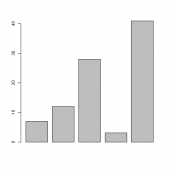列联表crosstable
列联表不仅可以用来做简单的描述性统计,还可以在机器学习中用来比较识别正确率,FPR,TPR等等数据,以便我们比较不同的ML模型 or 调参。
2x2列联表一般长下面这样:
|
1
2
3
4
5
6
7
8
9
10
11
12
13
14
15
16
17
18
|
Total Observations in Table: 143 | test_cancer$diagnosis lda.class | 0 | 1 | Row Total | -------------|-----------|-----------|-----------| 0 | 82 | 11 | 93 | | 0.882 | 0.118 | 0.650 | | 0.988 | 0.183 | | | 0.573 | 0.077 | | -------------|-----------|-----------|-----------| 1 | 1 | 49 | 50 | | 0.020 | 0.980 | 0.350 | | 0.012 | 0.817 | | | 0.007 | 0.343 | | -------------|-----------|-----------|-----------|Column Total | 83 | 60 | 143 | | 0.580 | 0.420 | | -------------|-----------|-----------|-----------| |
创建列联表crosstable
推荐使用R中“gmodels”包的CrossTable()函数来做。
举例
|
1
2
3
4
5
6
7
8
9
10
11
12
13
14
15
16
17
18
19
20
21
22
23
24
25
26
27
28
29
30
31
|
## 使用knn模型做预测knn_pred_1 = knn(train_cancer[,2:4], test_cancer[,2:4], train_cancer$diagnosis, k=1)## 创建列联表看预测效果CrossTable(x = knn_pred_1, y = test_cancer$diagnosis, prop.chisq = FALSE)> Cell Contents|-------------------------|| N || N / Row Total || N / Col Total || N / Table Total ||-------------------------| Total Observations in Table: 143 | test_cancer$diagnosis knn_pred_1 | 0 | 1 | Row Total | -------------|-----------|-----------|-----------| 0 | 77 | 8 | 85 | | 0.906 | 0.094 | 0.594 | | 0.928 | 0.133 | | | 0.538 | 0.056 | | -------------|-----------|-----------|-----------| 1 | 6 | 52 | 58 | | 0.103 | 0.897 | 0.406 | | 0.072 | 0.867 | | | 0.042 | 0.364 | | -------------|-----------|-----------|-----------|Column Total | 83 | 60 | 143 | | 0.580 | 0.420 | | -------------|-----------|-----------|-----------| |
注意事项
在crosstable函数中,prop.chisq 这个argument默认是true,但实际上大部分使用场景不需要这个卡方概率,所以可以单独在函数中设置prop.chisq = FALSE
函数语法:
|
1
2
3
4
5
|
CrossTable(x, y, digits=3, max.width = 5, expected=FALSE, prop.r=TRUE, prop.c=TRUE, prop.t=TRUE, prop.chisq=TRUE, chisq = FALSE, fisher=FALSE, mcnemar=FALSE, resid=FALSE, sresid=FALSE, asresid=FALSE, missing.include=FALSE, format=c("SAS","SPSS"), dnn = NULL, ...) |
参数说明:
x,y:列联表的两个特征向量
digit:指定结果小数位数
prop.r:行比例是否加入
prop.c:列比例是否加入
prop.t:表比例是否加入
prop.chisq:每个单元的卡方值是否加入
chisq:卡方检验结果是否加入
频数表
频数表给出了各个特征值出现的频数,下面使用R自带的数据集“CO2”举例
|
1
2
3
|
head(CO2)#得到“conc”特征的频数表table(CO2$conc) |
结果:
95 175 250 350 500 675 1000
12 12 12 12 12 12 12
补充:R--生成各种列联表
看代码吧~
|
1
2
3
4
5
6
7
8
9
10
11
12
13
14
15
16
17
18
|
library(vcd)head(Arthritis) table(Arthritis$Treatment,Arthritis$Improved)with(Arthritis,table(Treatment,Improved))mytable <- xtabs(~Treatment+Improved,data = Arthritis)with(Arthritis,xtabs(~Treatment+Improved,data = Arthritis)) margin.table(mytable,2) # sum by rowprop.table(mytable,2) #proportion by columnprop.table(mytable) #proportion by total addmargins(mytable)addmargins(mytable,1)addmargins(prop.table(mytable,2),1) library(gmodels)CrossTable(Arthritis$Treatment,Arthritis$Improved) ##SAS format |
以上为个人经验,希望能给大家一个参考,也希望大家多多支持服务器之家。如有错误或未考虑完全的地方,望不吝赐教。
原文链接:https://blog.csdn.net/Yann_YU/article/details/107359130















